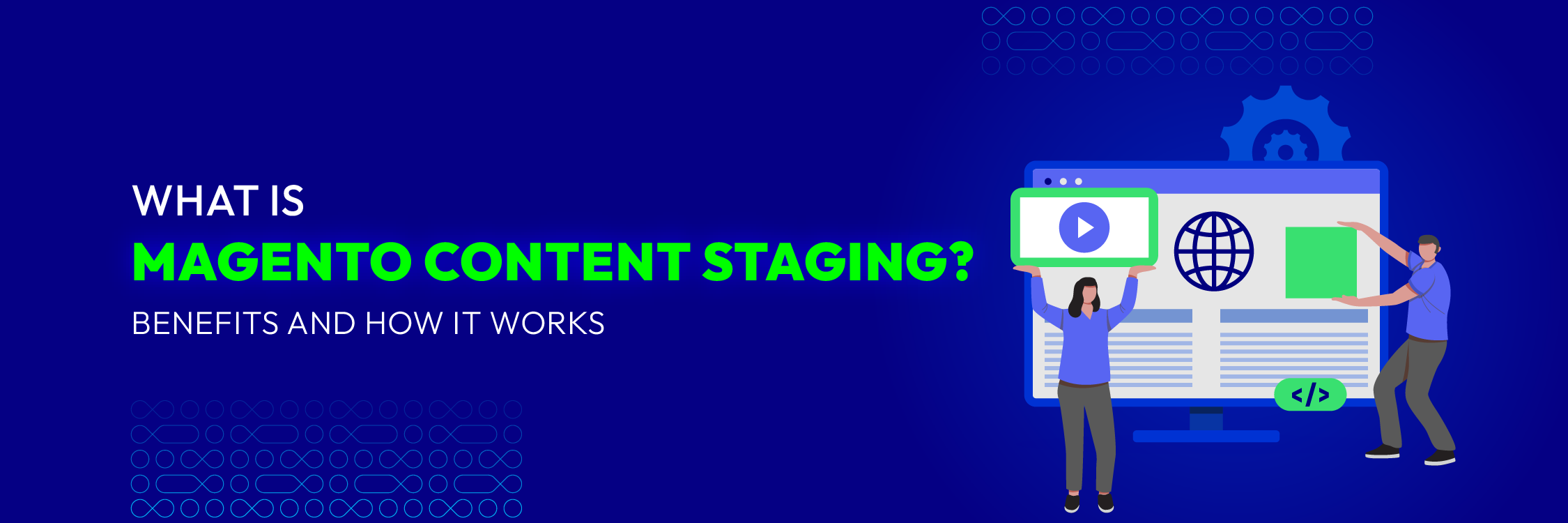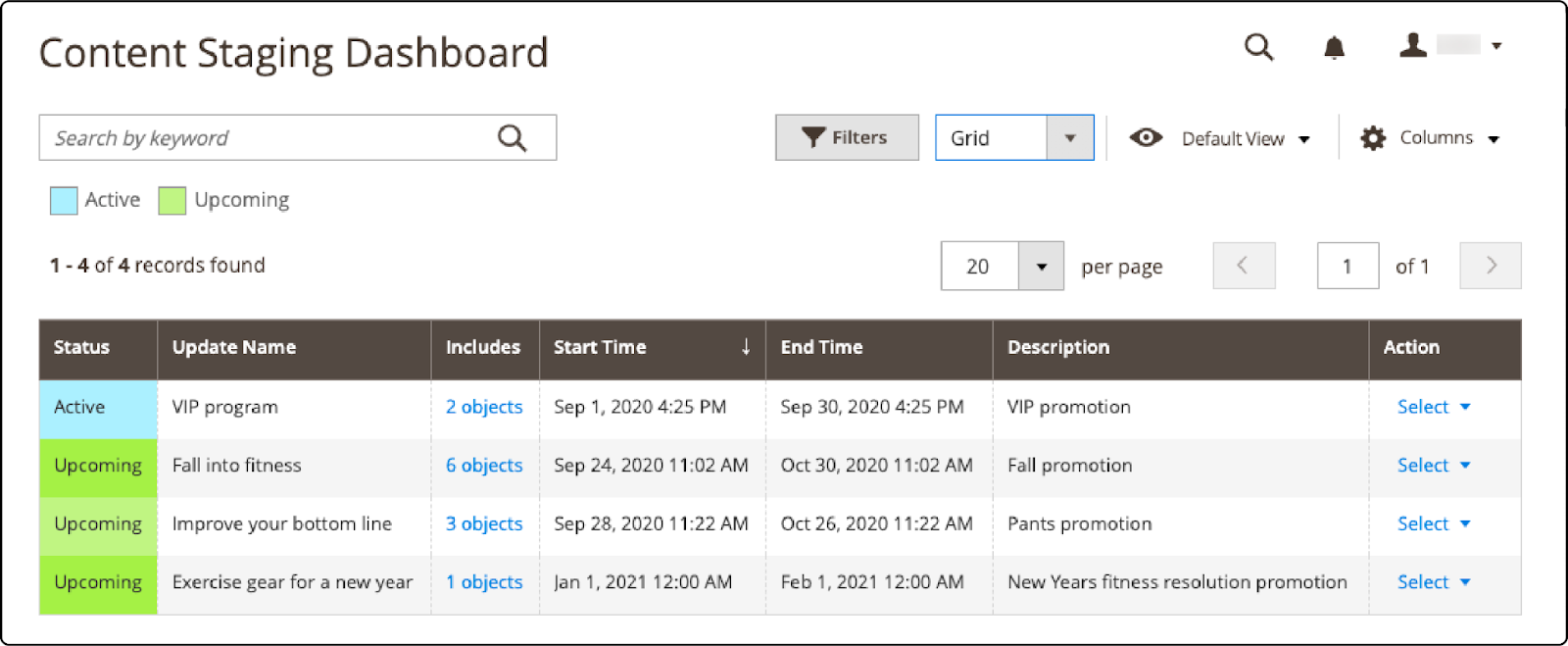What is Magento Content Staging? Benefits and How It Works

You may create and manage campaigns, oversee them via the dashboard, and regulate forthcoming store updates using Magento’s content staging feature. Previewing stores and scheduling site changes become simpler with this tool.
This article illustrates how to leverage this functionality for smoother task management. The staging environment, equipped with a database, web server, and all necessary services, mirrors the production setting closely.
What is Magento Content Staging?
Content Staging, an exclusive feature of Magento Commerce, empowers store proprietors to execute diverse content alterations directly from the backend panel.
Content staging enables your business team to easily create, preview, and schedule different content updates for your store right from the Admin interface. Instead of viewing a page as fixed, think of it as a combination of elements that can be turned on or off according to a schedule. Using content staging, you can design a page that evolves over the year as per a predetermined timetable.
Why is Content Staging important in Adobe Commerce?
With Magento content staging, your business team can easily create, preview, and schedule different content updates directly from the Admin panel.
Once scheduled, the updates will automatically go live at the specified time. No more late nights or early mornings to make changes manually. While exclusive to Magento Commerce, the value of content staging is evident: it keeps your store current and error-free with minimal effort.
Content Staging Objects & Campaigns in Magento
This feature simplifies scheduling updates. Whenever you plan a change for a listed item, a temporary “campaign” is automatically created. This triggers a “Scheduled Changes” notification at the top of the page.
These campaign placeholders have a start date but remain open-ended. They allow you to schedule content updates with previews and sharing options based on specific dates, times, or customer segments. Once you create a campaign for an item, you can easily assign it to schedule updates for other items.
This powerful tool lets you manage more than just content updates. You can schedule entire campaigns and more, giving you precise control over when your changes become visible to customers. Simply choose the exact date and time for your updates to go live.
The following entities are compatible with content staging:
- Products
- Catalog Price Rules
- Categories
- Cart Price Rules
- CMS Blocks
- CMS Pages
- Widgets
How does Magento content staging work?
1. Begin by creating the baseline content
The baseline represents the content of an asset without any ongoing campaign. It encompasses everything beneath the Scheduled Changes section at the top of the page. By default, the baseline content is always utilized unless there is an active campaign with scheduled modifications for that specific point in the timeline.
2. Launch the initial campaign
To start your first campaign, set the desired start and end dates. If you want the campaign to run indefinitely, leave the end date field empty. Once the first campaign concludes, the original baseline content will be restored.
3. Include a second campaign
To establish the second campaign, define the desired start and end dates. The second campaign can be scheduled for a completely different period. Remember, campaigns for the same asset should not overlap, so create as many campaigns as necessary.
4. Revert to the baseline content
Once all active campaigns have concluded, the original content is restored as the baseline, assuming all campaigns have specified end dates.
Magento content staging dashboard
The Content Staging dashboard offers scheduled site modifications and updates. You can preview and share any specific day, date range, or campaign duration with others.

Benefits of Content Staging in Magento
Magento Content Staging offers several benefits:
- It speeds up the process of making multiple content changes quickly.
- You can preview your updates before making them live.
- This tool enables you to plan and implement various types of content and products.
- You can pre-adjust your CMS Pages or Blocks.
- It’s integrated into Magento Commerce Cloud and complements other features seamlessly.
- By displaying different content to different customer groups, it helps boost sales.
- You can schedule sales events with specific start and end dates.
- Even if you’re new to Magento, it’s user-friendly.
- If issues arise, there are quick-fix options available directly in the dashboard.
FAQs
1. What does content staging in Magento 2 entail?
Content staging, a feature exclusive to Magento Commerce, streamlines the process of updating content. Instead of creating static pages, store owners can schedule content to be activated or deactivated as needed. For more detailed information, consult the developer documentation or reach out to your Magento admin for assistance.
2. What is the primary function of the Magento 2 private sales extension?
The Magento 2 private sales extension enables the creation of private sale events tailored to specific customer groups. It also incorporates a flash sales extension and a countdown ticker to enhance marketing efforts.
3. How do I establish a private sale page using Magento?
To create a private sale page with Magento, you need to install the Private Sales Extension. This allows you to restrict sales to particular members and schedule flash sale events.
4. Can I personalize my email templates in Magento?
Utilizing a third-party Magento theme, you can design custom email templates and incorporate an “add to cart” button for selected products after the conclusion of a flash event.
5. What hosting service is suitable for a Magento website offering content staging capabilities?
When selecting a Magento hosting providers, consider factors such as reliability, performance, and support capabilities. Opt for a hosting service with content staging capabilities if your website requires frequent content updates.
6. Does catalog events functionality aid in tracking marketing efforts?
Catalog events within this platform assist businesses in monitoring upcoming or ending private sales based on various events and categories, streamlining the configuration process.
7. Can multiple flash sale campaigns be run simultaneously on this platform?
Yes, extensions permit users to manage multiple flash-sale homepage categories within a single interface, offering adaptability to specific requirements.
Summary
Magento’s content staging functionality empowers store owners to execute various content updates directly from the backend panel. With this tool, you can strategize and evaluate your updates on the site. If you’re operating a Magento store, I highly recommend exploring this feature. This guide provided an overview of the fundamentals for setting up and utilizing content staging functionality.






![Top 20+ Must-have Shopify Apps for 2025 [Free & Paid] - Mageplaza](https://cdn2.mageplaza.com/media/blog/must-have-shopify-apps/top-must-have-shopify-apps.png)
![[2025 Updates] Top 10+ Upsell Apps for Shopify - Mageplaza](https://cdn2.mageplaza.com/media/blog/best-upsell-shopify-app/cover.png)